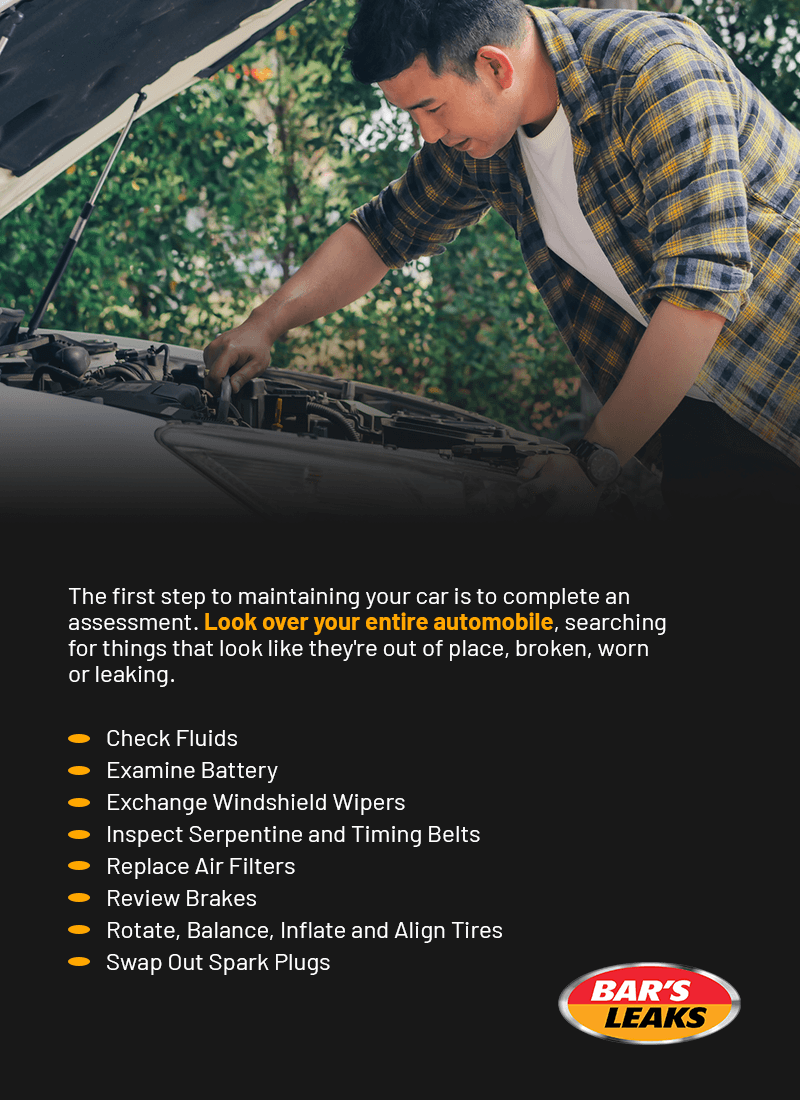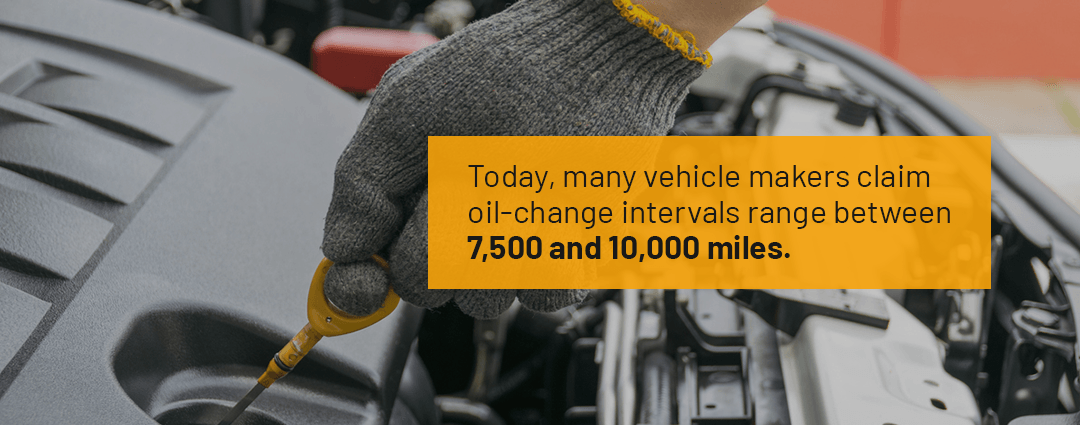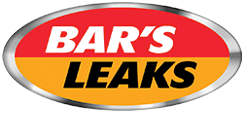Trying to figure out how often your car needs maintenance is similar to knowing when you’re due for a dental appointment. You take care of your teeth and refer to the experts when you need a check-up or when something is wrong — and the same goes for your vehicle.
Bar’s Leaks give you the power to resolve your automotive leaks and minor mechanical issues. It’s exciting to know you can perform repairs on your own, but it’s also imperative to understand when the experts may need to step in. We are always upfront with our customers – if a problem or repair is beyond a chemical repair threshold, we tell them to go visit a dealership or mechanic.

How Often Should My Car Get Inspected?
Sometimes it can be challenging to decipher what your car requires when it comes to regular maintenance and repairs. There are general timelines you can follow, but each automobile is different when it comes to needing an oil change, cooling system flush, or a new timing belt. It’s difficult to give overarching facts that cover cars, SUVs and trucks, but there are certain steps you can take to better understand your car’s needs, like:
Follow the Manufacturer’s Manual
This is the big one, obviously.
The best way to determine a good car inspection frequency is by referring to the manufacturer’s manual. Your owner’s handbook will indicate how to look after your specific make and model, while also telling you what type of oil, gas and other fluids work best. It also explains when each component will warrant upkeep. Look for a service interval description for your car in the manual.
Two maintenance schedules exist — normal and severe. You may want to look into more stringent maintenance if you drive in irregular traffic patterns, tow heavy trailers or operate off-road. Even if you drive in extreme hot or cold temps, a more rigorous upkeep schedule may work best for your situation.
If you want your car to last as long as possible, adhere to your manual’s maintenance schedule. Without following the right specs, you can void your warranty or cause serious damage to your vehicle.
Utilize Maintenance Reminder Systems
On top of observing your handbook, you can also use technology to track your regular upkeep. Maintenance reminder systems in modern and advanced vehicles record an upkeep program for you. The in-vehicle preventative tech takes many conditions into account and relays alerts when one needs attention. It tracks when your car needs work and provides future reminders.

You can also use mobile apps to help you oversee your vehicle’s mileage, fill-ups, service intervals, service expenses and repair history. Other options are to create a filing system by manually keeping track of your maintenance and costs.
Auditing your expenses and tracking upkeep can extend the life of any engine. Because maintenance varies by vehicle, it’s vital to stick to your exact specifications.
What Maintenance Can I Do Myself?
Preserving your car is one of the most prevalent ways to save money in the long-run while also extending the life of your engine. When you spend small amounts on upkeep, it will help you avoid high-priced overhauls down the line.
Your best bet is to be proactive. Never wait until something goes wrong to start repairs and never ignore preventative maintenance like changing the oil, topping up fluids and checking the tire pressure.

Conduct Proper Inspection
The first step to maintaining your car is to complete an assessment. Look over your entire automobile, searching for things that look like they’re out of place, broken, worn or leaking. Make sure everything is working, the liquids are topped up and the lights operate well. You should also listen for strange noises and be aware of smells when starting your engine.
1. Check Fluids
If you know how to change your car’s fluids, you’re one step ahead. But if you don’t, you should at least know how to check the levels of the oil, transmission, coolant, power steering, brake and wiper fluids. In some cases, you can see the level in the tank, while others require you to use a dipstick. Refer to your owner’s manual to know when a liquid change is necessary and top-up when needed.
If your power steering, cooling system or transmission shows problems, the right chemical solution can often make fast and effective repairs by sealing leaks, restoring seals and reducing noises.
2. Examine Battery
Inspect your car battery for leaks and ensure there is no corrosion around the contacts. Clean the unit with a wire brush to keep it in excellent condition. You can also invest in jumper cables when you need immediate help and a battery tester to remain up-to-date with its condition.
3. Exchange Windshield Wipers
Installing new windshield wipers when the rubber is cracked or worn is a simple DIY project. Even if the old ones are leaving streaks, fresh wipers will enhance your visibility during inclement weather.
4. Inspect Serpentine and Timing Belts
Refer to your owner’s manual to determine when you should replace the serpentine and timing belt. During your inspection, if the rubber gears are cracked or worn, take your car to a mechanic for belt replacement. You don’t want to wait until they fail because it can lead to damaged engine parts, which leads to expensive repairs and replacements. If the belts reach their life expectancy according to your handbook but are in good shape, you don’t need new ones.
5. Replace Air Filters
When necessary, swap out the cabin and engine air filters. Replacing the cab air filter is simple. It makes for a more comfortable ride because the filter cleans the air before it reaches the inside of the car. Don’t pay someone for work you can perform within seconds.
When it comes to your engine air filter, check your manual to see when your car needs a new one. It sometimes depends on a specified number of miles, or, if you see it’s dirty during regular inspections, replace it. Driving in traffic or completing longer commutes may make the filters dirtier than driving in open areas. Engine air filters prevent dirt, grime and contaminants from reaching your engine.
6. Review Brakes
The life of your brake pads is dependent on an assortment of factors, including your driving style. Replace your car’s brake pads and rotors according to your owner’s manual. If you see wear and tear during an inspection, you may need to implement replacement sooner than expected.
7. Rotate, Balance, Inflate and Align Tires
Preventative upkeep also requires you to check various components outside the car’s engine. For example, rotating and balancing your tires can help them last longer and will make sure they wear evenly, as it ensures a smoother and safer drive.
You will also want to inflate your tires to the proper PSI according to your manufacturer’s guide. Check the tires with an air pressure gauge. Riding on properly inflated tires can result in better mileage, safety and traction. Be especially diligent during cold weather because extreme temperatures can decrease air pressure faster.
Inspect the rubber components for wear, damage, tears, gouges, sidewall destruction and under-inflation. Any faults can affect your ability to drive and stop in various situations or even cause blowouts. To examine the tread depth of your tires, use a penny. If you can see the president’s head, you have less than 2/32” of a tread. As a result, you will need to replace the tire as soon as possible.
Take your time to keep up with the tires’ alignment as well. You shouldn’t have to fight your steering wheel to drive straight.
By conducting regular maintenance on your vehicle’s tires, you can help them last longer, whether you drive to work every day or embark on off-roading adventures.
8. Swap Out Spark Plugs
Check, clean and replace your engine’s spark plugs as specified by your manual. Swapping spark plugs varies between each make and model of car. If your vehicle has iridium or platinum spark plugs, they can remain intact for up to 60,000 miles. Ahead of that average, high-end iridium options can go to 120,000 miles.
If you don’t take the right precautions, corrosion buildup and worn components can affect the engine’s performance, demanding an immediate replacement.
Other maintenances you can make include cooling system and head gasket repairs. Blown head gaskets are often financially out of reach for most people, especially if you have an older vehicle. Because it doesn’t make economic sense to opt for a massive overhaul, you can rely on head gasket chemical solutions to repair leaks.
When temperatures reach extreme high or low levels, it can affect your car’s cooling system. You can prepare your car for winter and summer by using available cooling system products to help avoid a blown radiator and stop leaks.
You don’t have to be a professional mechanic to manage most of your car’s upkeep. Always make sure to check your owner’s manual to find what’s specific to your vehicle. Delaying or ignoring maintenance is never the right move because it can lead to time-consuming, expensive and in-depth repairs.
Can I Fix an Oil Leak Myself?
Yes, most car owners have no issue changing the oil themselves. Topping up and changing the fluid is vital if you want to keep a healthy engine. Follow your vehicle’s specifications to determine how often you should change your oil and what type works best for your car.
Because advances in oil and engine technology have improved over the years, the foretold “3,000-mile oil change” is long gone. Today, many vehicle makers claim oil-change intervals range between 7,500 and 10,000 miles. The increments have increased in time, making it more beneficial for your wallet and the environment.

Determining how often your oil needs to be changed is about more than mileage and time — it depends on the type of oil and other features, such as excessive idling, short-distance traveling, extreme temperatures and cold-starts.
It’s best to check the oil level when the engine is warm by using an electronic gauge or dipstick device, depending on your vehicle. It’s also essential to know the difference between clean vs. dirty oil. If it’s old, it will be murky or muddy in appearance. Contaminated fluid can indicate your engine is experiencing problems as well.
Experiencing an oil seepage can be a sign of severe engine problems or a simple leak you can fix. Adding the right engine chemical solution can seal leaks and enhance your engine’s performance. Always dispose of oil and other mechanical fluids properly according to your state’s laws and regulations.
When Should I Go to the Mechanic?
While you can perform many maintenance tasks on your own, some things require the work of a professional mechanic, like replacing a clutch, rebuilding a differential, performing bodywork or repairing the transmission. But knowing how often you should get your car inspected depends on your abilities and the severity of a problem.
During your regular inspections, you should keep a lookout for breaks, leaks, cracks, smells, sounds, low fluid levels, corroded areas and other complications. If you are able to keep up with regular maintenance and fix minor mechanical problems yourself, you’re in good hands.
Many states necessitate regulated inspections of vehicles. For example, Pennsylvania demands yearly inspections for drivers to operate a car.
If your vehicle is experiencing more severe problems or the check engine light is on, you will need to rely on the experts. You check engine light will need specific testing to pinpoint the system’s exact failure. From there, a mechanic can diagnose the situation and make repairs or replacements as necessary.
When you take your vehicle to the mechanic, it allows them to catch more serious issues that may be evolving. However, be aware of what your owner’s manual says compared to what a technician recommends. Many times, a mechanic’s suggestions differ from your handbook by way of several months or several thousand miles in difference. Adhering to your owner’s manual while considering a professional’s opinion can save you money.
Trust Our Advanced Chemical Solutions
It can be challenging to know how often your car needs maintenance, but when you stick to a regimented timetable, you can keep your vehicle in prime condition. Bar’s Leaks offers time-tested, OEM-proven chemical repair solutions that are safe, effective and simple to use. We can make a “three-minute mechanic” out of anyone with our affordable solutions. Our products support a multitude of automotive problems, ranging from the engine and cooling system to your car’s oil and head gasket components.
Browse our products online or reach out to a Bar’s Leaks representative for more information. Made in the USA, our top-tier chemical engineering solutions are here to keep you moving.


